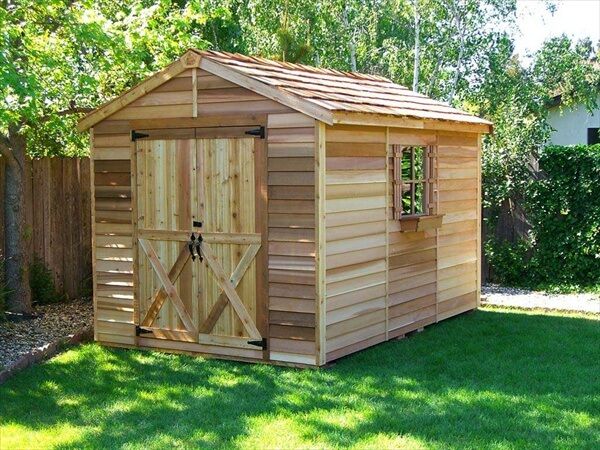
DIY Pallet Shed Plans for Cost-Effective Outdoor Projects
Constructing a shed can be a significant investment, both financially and in terms of time commitment. However, by utilizing readily available and inexpensive reclaimed materials such as pallets, a substantial reduction in overall costs can be achieved. This article provides comprehensive DIY pallet shed plans, guiding readers through the process of designing and building a functional and aesthetically pleasing outdoor storage solution.
Planning and Design Considerations
Before embarking on the construction process, meticulous planning is crucial to ensure the success of the project. Several key factors warrant careful consideration:
Determining Shed Dimensions and Functionality
The dimensions of the shed should be determined based on its intended use and the available space. Consider the items that will be stored within the shed and allow ample room for convenient access. Smaller sheds are simpler to construct and require fewer materials, while larger structures offer increased storage capacity. Accurate measurements are paramount; any discrepancies can significantly impact the structural integrity of the finished shed.
Sourcing and Assessing Pallets
The foundation of this project rests upon the acquisition of suitable pallets. Source pallets from reputable sources, ensuring they are free from rot, significant damage, and any hazardous materials. Inspect each pallet carefully; reject any showing signs of decay or structural weakness. The number of pallets required will depend on the shed’s planned dimensions and design.
Choosing a Suitable Location
The location of the shed should be carefully chosen, considering factors such as sun exposure, proximity to utilities, and accessibility. Ensure the ground is level and provides adequate drainage to prevent water accumulation and potential structural damage. Obtaining necessary permits before commencing construction is essential, particularly for larger structures or those situated in areas with stringent building regulations.
Materials and Tools Required
Beyond the reclaimed pallets, several additional materials and tools are necessary for the successful completion of the project:
Essential Materials
- Concrete blocks or treated lumber for the base: Providing a stable foundation prevents the shed from settling unevenly.
- Screws and nails: Galvanized or stainless steel fasteners are recommended for enhanced durability and weather resistance.
- Wood glue: Supplementing the fasteners with wood glue increases the structural integrity of the joints.
- Plywood or sheet metal for roofing: Choose a material that provides sufficient weather protection and complements the overall aesthetic.
- Paint or sealant: Protecting the wood from the elements extends the shed’s lifespan.
- Hinges and a latch for the door: Select sturdy and weather-resistant hardware.
Essential Tools
- Measuring tape and level: Accuracy in measurements is critical for a structurally sound shed.
- Hammer and screwdriver (or drill): Essential for securing the pallets and other materials.
- Saw (circular saw or hand saw): Used to cut pallets and other materials to size.
- Safety glasses and gloves: Protecting your eyes and hands is paramount throughout the construction process.
- Shovel (for preparing the base): Leveling the ground and creating a stable foundation is critical.
Step-by-Step Construction Guide
The following steps provide a detailed guide to constructing your pallet shed:
Foundation Construction
Begin by preparing a level base. This can be achieved by laying concrete blocks or constructing a simple frame using pressure-treated lumber. Ensure the base is level and large enough to accommodate the shed's dimensions. This foundation provides stability and protects the pallets from direct ground contact, mitigating rot and decay.
Pallet Assembly and Wall Construction
Carefully disassemble the pallets, removing any loose or damaged components. Inspect the remaining wood for any signs of rot or insect infestation. Construct the shed walls by vertically stacking and securing the pallets using screws and wood glue. Ensure the walls are plumb and aligned. The number of pallets used per wall will depend on the overall height of the desired structure.
Roof Construction
The roof design can vary depending on preference and the shed’s dimensions. A simple gable roof or a flat roof can be created using plywood sheets or sheet metal. Ensure adequate overhang to protect the walls from rain and snow. Secure the roofing material to the top of the assembled walls using screws and appropriate sealants.
Door Installation and Finishing Touches
Create the shed door by using additional pallets, constructing a frame, and attaching hinges and a latch. Consider adding a lock for enhanced security. Once the door is installed, apply a weather-resistant paint or sealant to all exposed wood surfaces to protect against the elements. This extends the lifespan of your shed.
Safety Precautions and Considerations
Safety should be a paramount concern throughout the construction process. Always wear appropriate safety gear, including safety glasses and gloves. When using power tools, ensure proper training and adherence to safety guidelines. Be aware of the potential hazards associated with working with wood and other materials. Proper disposal of any waste material is crucial, ensuring adherence to local regulations.
Cost Savings and Environmental Benefits
Utilizing reclaimed pallets significantly reduces the overall cost of constructing a shed compared to using new materials. This approach also offers significant environmental benefits by promoting sustainability and reducing waste. By repurposing existing materials, the project contributes to a more eco-friendly approach to outdoor construction.
Conclusion
Building a DIY pallet shed provides a cost-effective and environmentally conscious solution for outdoor storage needs. With careful planning, attention to detail, and adherence to safety guidelines, the construction process is achievable for individuals with moderate DIY skills. This comprehensive guide serves as a practical roadmap, enabling you to create a functional and aesthetically pleasing shed that enhances your outdoor space.
0 comments:
Post a Comment
Note: Only a member of this blog may post a comment.